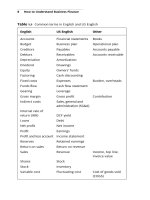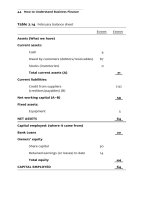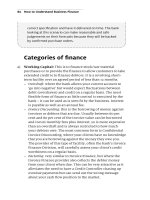The m word journal how to have the money talk
Bạn đang xem bản rút gọn của tài liệu. Xem và tải ngay bản đầy đủ của tài liệu tại đây (5.47 MB, 97 trang )
Praise for
THE M WORD JOURNAL:
HOW TO HAVE THE MONEY TALK
“Successful wealth management often starts with open and honest conversations about money and its
role in a family’s life goals. Lori Sackler’s The M Word Journal is a practical handbook for anyone
looking to have these critical Money Talks with their parents and children across a wide range of life
events. With easy-to-follow worksheets and instructions, the book guides you through these important
and sometimes difficult conversations to help secure your family’s financial future. ”
—Shelley O’Connor, Co-Head of Wealth Management, Morgan Stanley
“With her insightful book The M Word , Lori Sackler showed us how to tackle the difficult financial
decisions that families face such as when to retire and how to care for elderly parents. Now with The
M Word Journal , she spells out the concrete steps families must follow to tackle these decisions
successfully. ”
—Richard Marston, Professor of Finance and Director of
the Private Wealth Management Program at the Wharton School
“The M Word Journal is an accessible easy-to-use workbook that will help address one of the most
difficult of life’s issues—money. The book takes readers with simple questions and templates through
the most volatile of money situations: changes, remarriage, retirement, elderly parents, and
inheritance. If using this workbook serves as the catalyst for even an hour-long conversation on any of
these topics, both you and your loved ones will benefit handsomely. ”
—Martin M. Shenkman, CPA, MBA, AEP, PFS, JD, estate attorney and author
“Lori Sackler continues to dazzle and sparkle with her wise investment judgment and her experiencebased insights into the complexities of family dynamics and the money conversations ensuing
therefrom. The M Word Journal provides THE detailed roadmap for all investors and their family
members to successfully navigate life’s defining transitions. ”
—David M. Darst, CFA, Founder of, Senior Advisor to, and member of Morgan Stanley’s
Global Investment Committee
“How to Have the Money Talk! With insight and knowledge, Lori Sackler in the M Word Journal
takes the reader through the steps that will lead you through the productive conversations necessary
for successful financial decisions. In concert with the M Word , she will help reduce the financial
anxiety and stress in your life and enhance your overall sense of well-being. ”
—Hendrie Weisinger, Ph.D., New York Times bestseller, Performing Under Pressure:
The Science of Doing Your Best When it Matters Most
“This journal is very well organized with an array of practical charts for each life transition category.
I especially appreciate Lori’s thoughtful, positive approach in asking the many open-ended questions.
A most mindful guide to having conversations about money. ”
—Eileen Gallo, PhD, coauthor with Jon Gallo of Silver Spoon Kids
The M Word Journal:
How to Have the Money Talk
by Lori R. Sackler
© Copyright 2016 Lori R. Sackler
ISBN 978-1-63393-254-8
All rights reserved. No part of this publication may be reproduced, stored in a retrieval system, or transmitted in any form or by any
means – electronic, mechanical, photocopy, recording, or any other – except for brief quotations in printed reviews, without the prior
written permission of the author.
Morgan Stanley is held harmless with regard to any legal or other issues that may arise from the advice and examples used in this book.
Tax laws are complex and subject to change. The information in this book is based on current federal tax laws in effect at the time the
book was written and should not be construed as advice on tax and tax accounting matters. Individuals should consult their own legal, tax
investment, or other advisors to determine the laws and analyses applicable to their specific circumstances.
Published by
210 60th Street
Virginia Beach, VA 23451
212-574-7939
www.koehlerbooks.com
CONTENTS
Introduction
Acknowledgments
Chapter 1: Changes in Financial Circumstances
Chapter 2: Remarriage and Merging Families
Chapter 3: Retirement Planning
Chapter 4: Caring for an Elderly Parent
Chapter 5: Preparing Heirs and Estate Transfers
INTRODUCTION
Since the 2013 publication of my first book, The M Word: The Money Talk Every Family Needs to
Have about Wealth and Their Financial Future, I have learned that my M-Word message definitely
resonates. Regardless of the level of wealth, size, cultural background, configuration, or gender
composition, every family struggles with successfully handling money issues and the money talks that
are essential to avoid failure. The conversations, like the financial challenges, are complicated and,
for some, can be terrifying—which is why I wrote The M Word . It provides a five-step process to
guide individuals and families through the talks and ultimately the major life events, or transition
points, that make the talks necessary.
The response to my book continues to be extremely positive, affirming, and personally rewarding.
Some of the most insightful feedback from readers, including the April 6, 2013 New York Times
review, reflects a need for more substantive tools and specific guidance for family discussions. The
M Word helps the public understand why the “Money Talk ” is such a daunting task given the many
conscious and unconscious factors that interfere and provides compelling arguments for having the
conversations. But the book does not focus enough on the “how to ” step in the process—how to
actually talk to your family about money does matter. Readers need a more comprehensive road map
for the conversations: hence, the reason for The M Word Journal: How to Have the Money Talk.
The M Word Journal will provide individuals and families a detailed outline for asking the right
financial questions at each transition point, for gathering the necessary financial information, and for
preparing and conducting the talks. I believe it will serve as the foundation for conversations between
the parties to the discussions for both family members and their advisors. You may not be able to get
through the complete questionnaire and road map because The M Word Journal, by design, is
comprehensive. Also, you may need to refer to my first book, The M Word , as you make your way
through this one. But having a disciplined approach embodied in this document, and sharing this
document with others, may help you and your family keep your money and family relationships intact
as you struggle with life’s challenges. The M Word Journal is a vehicle to generate interest among
those involved, get each other’s feedback, and ultimately spark members of the family to action.
I’ve spent considerable time trying to include all the questions and fact-gathering elements necessary
to master each of the five transition points I’ve identified. I hope you will feel inspired to explore
issues on your own and by doing so, create your own personal, tailored approach. My goal is to help
you move the process along.
Good luck with your Money Talks!
ACKNOWLEDGMENTS
As with my first publication, there are many people to thank for their work, wisdom, wealth of
professional insights, and input into this project. My agent, Leah Spiro, as with The M Word: The
Money Talk Every Family Needs to Have about Wealth and their Financial Future , was a principal
contributor to The M Word Journal’s evolution, guiding me with her special brand of publishing
expertise and experience, from the original concept, to manuscript, and finally to actual print with lots
of weekly phone calls and weekend reviews along the way. Mark Levine, my editor for The M Word,
played a critical role in the development of the content, and I will always be grateful for his logical
and very thoughtful approach. Special thanks also goes to Tom Lau, the art director on the project, for
his creative input and interactive touch on the final presentation.
The professionals at McGraw-Hill—Donya Dickerson, Christopher Brown, and Yin Chan were
critically important to the release of the second edition of The M Word: The Money Talk , for which I
am very grateful. And I am especially appreciative of the professionals at Koehler Books–John
Koehler, Joe Coccaro, and Cheryl Ross, who worked diligently to realize my goal and dream of
bringing The M Word Journal to the public.
I am particularly grateful to the wonderful people at Morgan Stanley who spent considerable
professional time and energy at various stages of the project so that I could give birth to ANOTHER
manuscript. My sincerest gratitude to my best-ever branch management team: Rich Less, Ardell Roan,
Kathe Koch, George Batelli, Ed Wilson, Bo Skala, and the best-in-class legal, compliance, and
wealth management team at Morgan Stanley: Rick Apicella, Glenn Kurlander, Vincent Lumia, Les
Klein, and Paul Stam.
The marketing professionals at Morgan Stanley: Jim Wiggins, Margaret Draper, and Christine Jockle
have been extremely supportive of my M-Word message over the years in a variety of impactful
ways, including connecting me with Michael London and his colleague Debbie Levinson, both
consummate public relations professionals with whom I have enjoyed working. And my publicist and
public relations partner, Meryl Moss, and her staff have been essential in my efforts to get The M
Word: The Money Talk into the public domain and are now spreading the word about The M Word
Journal: How to Have the Money Talk.
Special thanks to the members of my Morgan Stanley team, the Sackler Group at Morgan Stanley:
Henry Sackler, my partner, who by his hard work and enormous contributions to the practice has
helped free up my weekends and evenings to give me time to devote to the project; and my assistants,
Nancy Hecker and Chantana Suwansiri, who make a difference in their daily commitment to our
mission of caring for our clients and their families.
My dear family, husband Michael, and sons Eliot and Henry, are the essentials in my life and part of
the reason I’m motivated to give back in a more public way through The M Word and my community
volunteer projects.
And, finally, thanks to the Sackler Group clients who have played an enormous role in the evolving
M-Word concept. They continue to challenge our thinking and approach to wealth management while
giving us a sense of pride and joy in the work that we do for them each day.
CHANGES IN FINANCIAL CIRCUMSTANCES
HAVING MONEY TALKS WHEN DISASTER STRIKES OR
WHEN GOOD FORTUNE COMES YOUR WAY
I’m living so far beyond my income that we may
almost be said to be living apart.
—E.E. CUMMINGS
O
ur financial circumstances undergo significant changes over the course of our lifetimes, and our
family members’ financial situations change as well. Whether it’s a death, a work promotion, or
a business reversal, change is a fact of life and these changes can be either positive or negative. If we
don’t adapt to the new situations, align income and expenses, and get the participants on board, the
repercussions could be serious. Under normal circumstances, the subject of money is difficult for
families to discuss. When there have been significant changes in financial circumstances, the natural
human tendency is for everyone to shut down emotionally and avoid the conversation.
But not discussing these life changes can be costly—and not just in dollars and cents. Existing issues
and family conflicts are likely to be exacerbated, and new ones are apt to emerge along with the
ramifications of changed financial circumstances. Acknowledgment, disclosure, and discussion are
the keys to emerging from these changes with family finances and dynamics intact.
Note: Before you address the specific issue you are facing, make sure you have updated your personal
financial inventory and records. You will need access to the most up-to-date information in order to
complete this M Word Journal, which is designed around the following five steps:
1. Gather information about the transition point you are facing, and identify and prepare
for the issues and topics that need to be discussed.
2. Consider the factors that are interfering with you and your family having the Money
Talk and how to overcome them.
3. Plan the Money Talk physically, logistically, and psychologically.
4. Determine what professional help you may need for the Money Talk.
5. Create a process, repeat it, and anticipate and plan for future Money Talks.
PLEASE NOTE: For an in-depth explanation of the Money Talk and other concepts in this
Journal, see The M Word: The Money Talk Every Family Needs to Have about Wealth and Their
Financial Future (McGraw-Hill Education, 2013, updated 2016).
STEP 1: Gather information about the transition point you are
facing, and identify and prepare for the issues and topics that need to be discussed.
1.1: REVIEW YOUR ASSETS.
ASSET
ESTIMATED AMOUNT
Bank accounts
Brokerage accounts
Securities
IRAs/Profit sharing/401(k) plans
Stock options/Restricted stock/Deferred compensation
Pensions/Annuities
Insurance (cash value)
Real estate
Autos
Home furnishings
Collectibles
Other/Business interests/etc.
Total
1.2: REVIEW YOUR LIABILITIES.
LIABILITY
AMOUNT
Mortgage balances
Auto loans
Student loans
Personal loans
Personal lines of credit
Credit card balances
Personally guaranteed business loans
Other itemized debts
Total
1.3: REVIEW YOUR FAMILY’S CURRENT INCOME STREAM.
EARNED INCOME
Spouse/Partner 1
MONTHLY
ANNUALLY
Spouse/Partner 2
Total
INCOME FROM
INVESTMENTS/SECURITIES
Spouse/Partner 1
Spouse/Partner 2
Total
INCOME FROM BUSINESS
INTERESTS AND REAL
ESTATE
Spouse/Partner 1
Spouse/Partner 2
Total
INCOME FROM SOCIAL
SECURITY,ANNUITIES,
PENSIONS,IRAS,401(K)S,
ETC.,IF AVAILABLE
Spouse/Partner 1
Spouse/Partner 2
Total
INCOME FROM OTHER
SOURCES1
MONTHLY
MONTHLY
ANNUALLY
ANNUALLY
MONTHLY
ANNUALLY
MONTHLY
ANNUALLY
Spouse 1
Spouse 2
Total
WHAT IS YOUR TOTAL
INCOME?
Earned income
Investments/securities
Business interests/real estate
MONTHLY
ANNUALLY
Social Security and retirement
assets
Other Sources
Total
1.4: REVIEW YOUR FAMILY’S CURRENT EXPENSES AND OBLIGATIONS.
EXPENSE
Primary home2
Secondary home3
Food
Clothing
MONTHLY
ANNUALLY
1.4: REVIEW YOUR FAMILY’S CURRENT EXPENSES AND OBLIGATIONS (CONTINUED).
EXPENSE
Personal entertainment
Utilities4
Personal transportation5
Other debt service6
Taxes
Professional fees
Travel
Dues and memberships
Insurance7
Education8
Child support
Alimony
Pension contribution
Regular savings
Total
EXPENSES RELATED
TO NON-DEPENDENT
CHILDREN AND PARENTS9
MONTHLY
MONTHLY
ANNUALLY
ANNUALLY
Total
1.5: CALCULATE THE CURRENT SURPLUS OR SHORTFALL.
MONTHLY
ANNUALLY
Total income
Total expenses and obligations
Surplus or shortfall
1.6: If there is a shortfall, can you restructure or pay off any of your debts?
DEBT
MONTHLY SAVINGS
ANNUAL SAVINGS
Total
1.7: If there is a shortfall, can you trim any of your living expenses and obligations?
EXPENSE
MONTHLY SAVINGS
ANNUAL SAVINGS
Total
1.8: If there is a shortfall, can your family develop any new streams of income, such as a
nonworking spouse going to work, a family member who is working part time going full
time, or a dependent child getting part-time employment?
ADDITIONAL STREAM OF
INCOME
MONTHLY INCREASE
ANNUAL INCREASE
Total
1.9: If there is a shortfall, consider reductions in contributions to adult non-dependent children,
parents, and charitable donations.
CONTRIBUTION
MONTHLY SAVINGS
ANNUAL SAVINGS
Total
1.10: If there is a shortfall, consult with your financial advisor regarding other possible changes
to cope with reduced circumstances such as the sale of real estate, a business interest,
securities, or personal property (art, collectibles, etc.).
POSSIBLE CHANGE
Total
MONTHLY SAVINGS
ANNUAL SAVINGS
1.11: If there is a surplus, consult with your financial advisor and update your financial and
estate plans to reflect the “new normal. ” Consider expanding your investment portfolio,
investing in an existing or new business, purchasing a second home, incorporating selective
lending opportunities, and increasing gifts and charitable giving.
STEP 2: Consider the factors that are interfering with your family having the Money Talk
and how to overcome them.
2.1: How has money been used as a means of control in your immediate family? How has that
affected the various relationships, and how does it continue to inform them?
2.2: In what ways are money and trust bound together in your immediate family culture? How
does that play out in family relationships, collectively and individually?
2.3: What is the historical role of each member of the immediate family when it comes to
money? Has someone been the caretaker, while someone else has always needed to be
cared for? Has a member of the family always been responsible and independent, while
another member has always been irresponsible and more dependent? How will changes in
the family and money structure affect these roles?
2.4: Accept that gender differences have roots in physiology and as a result, anticipate some
conflicts. Which differences will be at work in your situation: risk-taking, prioritizing of
goals, setting a time horizon, or all three?
2.5: Be aware of the ingrained thinking patterns that influence decisions. What are the issues in
this situation that could lead to a struggle between emotion and reason when it comes to
making money decisions? For example, . . .
2.6: Understand that people are hardwired to see money as an object of threat and control,
causing them to respond instinctively. Which of the six basic instincts—shelter seeking,
care soliciting, caregiving, cooperation, beauty, and curiosity—are likely to arise in each
of the participants, and what are the best ways to address them? (Refer to chapter 8 of The
M Word.)
2.7: Understand generational differences in money perceptions and values. What generational
differences will you face in this situation? What language can you use that is age- and
generation-appropriate?
2.8: Think about your extended family’s history with money. Has the relationship that parents
and grandparents had with money been passed down to any of the other participants in the
Money Talk? For example, historically, has money been used as a substitute for love or a
tool for control or for some other tactic? How might this history play out in the current
situation, and how can you address it?
2.9: Understand that culture and experience affect attitudes about money. Are there any cultural
or regional differences in attitudes that you will face in this Money Talk? Is the immigrant
experience “fresher ” for some participants of the Money Talk than others?
2.10: Couple politics can also impact Money Talks, particularly when one partner surpasses the
other in education and/or earning power. Are there any such issues that you will face in this
Money Talk?
STEP 3: Plan the Money Talk physically, logistically, and psychologically.
3.1: Have you ever held a Money Talk before? If so, what happened?
3.2: What do you think made earlier Money Talks successes or failures?
3.3: What are your concerns, if any, about holding this particular Money Talk?
3.4: What are your objectives or goals for this Money Talk? What do you want to accomplish?
3.5: What are the specific financial issues and topics you’ll need to address that were identified
in Step 1?
3.6: Are there any potentially problematic family issues that are likely to arise? Are there factors
related to control, trust, family health, gender, marriage politics, evolutionary patterns,
instinctive behavior, family history, culture, age, attitude, etc.? (This topic is covered in
Chapters 8 and 11 in The M Word.)
3.7: Is there anyone in the family with whom communicating is frequently challenging? If so,
who?
3.8:Is there anything you can do to overcome these factors and individual challenges?
3.9: Using professional communication techniques (discussed in Chapter 9 in The M Word), answer
who, what, when, where, and how to have the talk before sitting down for the conversations. Create
an agenda based on the issues at play and the players that need to be present. Chapter 3 in The M
Word includes a sample agenda and more discussion around creating an agenda tailored to your talk.
3.10: Well in advance of the Money Talk, send a summary agenda to everyone who will be party
to the conversation so they can be prepared to discuss the topics and, if appropriate,
address them in advance with their advisor(s). Speak to each participant before the meeting
regarding the meeting objectives and their particular concerns, and make any necessary
changes to the agenda to reflect additional issues raised. Inform participants that
communication devices are not permitted during the talks. Make sure you have agendas
printed and available at the Money Talk.
3.11: Based on the agenda, write a “script ” for exactly what you want to say and how you want
to say it, and then rehearse it.
3.12: Consider times and settings for the talk that can create a safe and comfortable environment.
(Refer to Chapter 8 in The M Word.)
3.13: To enhance the chances for success, apologize for any role you may have played in
creating family conflict. Develop appropriate language and tone to help facilitate caring
and cooperation.
3.14: Plan a question-and-answer session and your responses to anticipated concerns and
expressions of anger or resentment using inquiry, acknowledgment, advocacy, and problem
solving techniques. (Refer to Chapter 9 in The M Word.)
3.15: Plan to discuss changes you will need to make to your current lifestyle that could impact
other family members.
3.16: Plan to discuss changes to your long-term financial planning that could impact other family
members.
STEP 4: Determine what professional help you may need for the Money Talk.
4.1: Do you have an advisor(s) who can help you with your collective and individual tax, estate,
and financial planning?
YES
NO
4.2 If you have an advisor(s), have you discussed with them your ideal outcome for the talk and
the financial issues and topics that may need to be discussed? If you do not have advisors,
what professionals do you think you need in order to create the right team?
ACCOUNTANT
ATTORNEY
FINANCIAL ADVISOR
MENTAL HEALTH PROFESSIONAL
OTHER
4.3: If you do have a team and you want to replace one or more members, who are they? Why
are you not satisfied with them? What traits would you look for in replacement members
that the current members of your team lack?
4.4: Does your advisor(s) have the right combination of licenses, credentials, experience, and
knowledge in the areas you need?
YES
NO
4.5:. Do they have the necessary character and chemistry as well as the communication skills









